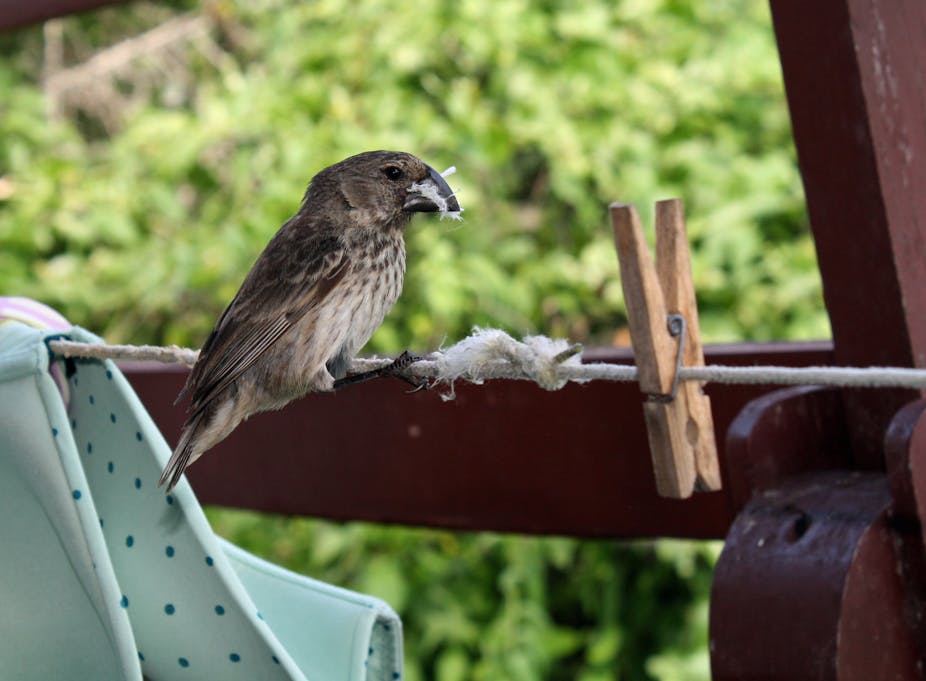Darwin’s finches, a group of 14 species found only in the Galapagos Islands, are perhaps most well known as one of the inspirations for Charles Darwin’s theory of evolution by natural selection. A classic example of adaptive evolutionary radiation, the species are similar having formed from a common ancestor, except for their beaks, which have specialised to tackle different food.
Invasive pests and parasites are a problem in many parts of the word, and have even reached the Galapagos: a parasitic nest fly Philornis downsi has spread to most islands in the archipelago and is wreaking havoc on Darwin’s eponymous finches and other birds. The fly’s larvae live in the birds’ nests where they feed on the young birds’ blood, sometimes killing the entire brood.
This parasitic fly might be the final nail in the coffin of some critically endangered species of Darwin’s finches, such as the mangrove finch and medium tree finch. So finding a way of controlling the pest is a top priority at the Galapagos National Park and Charles Darwin Research Station (CDRS), and with a novel method of putting pesticides right where it hits the pests – in the nest – we think we’ve found a solution.
One afternoon while lounging in my hammock at CDRS I noticed a female finch land on my laundry line. I snapped a few photos of her as she tugged cotton fibres from a frayed knot. As she flew off with the collected fibres in her beak, I wondered if finches would incorporate cotton treated with a low concentration (1%) of a mild insecticide (permethrin) into their nests. We have used permethrin to kill the parasite in Darwin’s finch nests for years without harm to the birds, and if the finches took the cotton they would be threading their nests with the very weapon they need to kill P. downsi. Later that day, I pinned cotton balls sprayed with permethrin to the laundry line. Within a few days, all of the cotton balls had disappeared from the rope.

Inspired by these observations, my colleagues and I designed an experiment in 2013 to test whether Darwin’s finches could be encouraged to “self-fumigate” their nests with cotton balls treated with permethrin. Separately, we also directly sprayed other nests with permethrin to determine if killing the parasites would increase finch nestling survival.
Our research team built 30 cotton dispensers, a bit like suet bird feeders but with cotton balls to pluck instead of food. Some were loaded with pesticide-treated cotton and others with water-treated cotton as a control, and we placed these around our main field site, El Garrapatero on the island of Santa Cruz.
Then over several months, we battled uneven lava rock underfoot and 40°C heat in search of finch nests. During an especially difficult day, I saw for the first time a finch taking cotton from a dispenser and bringing it back to her nest – a nest which turned out to contain nearly two grams of cotton. With more than 85% of the nests we found containing cotton, the finches certainly liked it as a nesting material. But did the pesticide work?

We found that nests which contained more than one gramme of permethrin-treated cotton (62% of nests) were virtually parasite-free, compared to nests with untreated cotton, which contained on average 30 parasites. Those nests that were sprayed directly with permethrin also had fewer parasites and more surviving nestlings. Given the tools to do so, finches can carry out their own pest control.
Since the fly is found almost everywhere in the Galapagos, we do not believe that it will develop resistance to permethrin, especially if the dispensaries are used over a smaller area. We believe that self-fumigation can be especially useful for endangered species such as the mangrove finch – this Darwin’s finch species is down to fewer than 80 remaining individuals. We presented our findings, now published in Current Biology, to researchers at CDRS, who are now putting out untreated cotton for mangrove finches to determine if they will be interested in the nest material. Self-fumigation provides an immediate solution to the parasite problem while other long-term methods are developed.
Of course there are other species of birds that are hurt by parasites, and if those birds too can be encouraged to incorporate fumigated cotton into their nests, they should be able to reap the benefits too. For example, Hawaiian honeycreepers become infested with feather lice, birds in Puerto Rico are afflicted by Philornis flies, and the endangered Florida scrub jay suffers from parasitic fleas.
The same method might be used for the black-tailed prairie dog, which while removed from the endangered species list is still declining on the Great Plains and is affected by flea-bourne plague. Spraying permethrin directly into burrows has been used but is labour-intensive – it might be possible to spray the pesticide onto vegetation that the animals then drag into their burrows.

